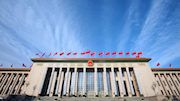The measured response of Chinese policymakers to the economic impacts of Covid-19 is expected to fuel greater appetite among global investors for domestic securities.
According to Amundi’s outlook on key investment themes, allocation to China equities will grow as a diversifier to US and EU equity exposure. “China gives exposure to a consumption story and can be complemented with US (IT) and EU equities on the cyclical and financial side,” explained Vincent Mortier, the asset manager’s deputy chief investment officer.
At the same time, the continued expansion of China’s economy, driven by a mix of international trade and domestic consumption, will be reflected in a higher weighting of Chinese equities in emerging market (EM) indexes, he added.
China bonds, meanwhile, have the potential to become core within global portfolios. “When real rates are low, Chinese assets are appealing in a global fixed income portfolio,” said Mortier.
Chinese conservatism
It is notable that China has been one of the few countries to avoid pursuing an unconventional path for monetary policy over the past 12 months or so.
While policymakers in the US, Europe and Japan have expanded their balance sheets at unprecedented levels in response to the pandemic, China has been more cautious. Indicative of this, the balance sheet of the People’s Bank of China shrank over the first four months of 2021.
China is also targeting an orderly slowdown of credit growth. Furthermore, the renminbi could become a reference currency for Asia as its internationalisation proceeds, he added.
With the overarching goal to control leverage, China’s prudent and flexible policy mix, combined with a weaker credit impulse, is expected to result in mild deleverage in 2021, but without any sharp turn in the macro policy mix.
For example, explained Mortier, total social financing – a credit proxy – should grow at a slower pace in 2021 and the total debt-to-GDP ratio might drop mildly this year. “Recent data shows that China could deleverage more than projected in 2021,” he said.
Robust Asian outlook
Also clear from the Covid-19 crisis is the fact that Asian economies are among the least vulnerable across all EMs.
“EM Asian manufacturing economies have come out of the Covid-19 crisis reinforced, with the external vulnerability index mostly in positive territory and showing some improvement,” said Mortier.
The post-pandemic recovery path in the region is also targeting more inclusive and sustainable growth, such as by investing in infrastructure, strengthening social protection and addressing climate threats.
On the other hand, inflation is on the rise globally, driven by base effects, accelerating demand and supply chain bottlenecks. “We believe in a structural shift towards higher inflation,” said Mortier. “Such risk is underestimated by markets, while above potential growth may be overestimated.”
Asian countries are among those EM nations facing increasing inflation pressures – mostly coming from food as well as the synchronised price rises on commodity markets.
“Food inflation has risen and is driving inflation in countries where the food import bill is relevant,” said Mortier. “In most EMs, food represents a large share of the inflation basket.”
In addition, the cost of shipping goods from China to Europe and the US has ballooned since January 2020, due to a combination of container shortage and recovering consumer demand.

















